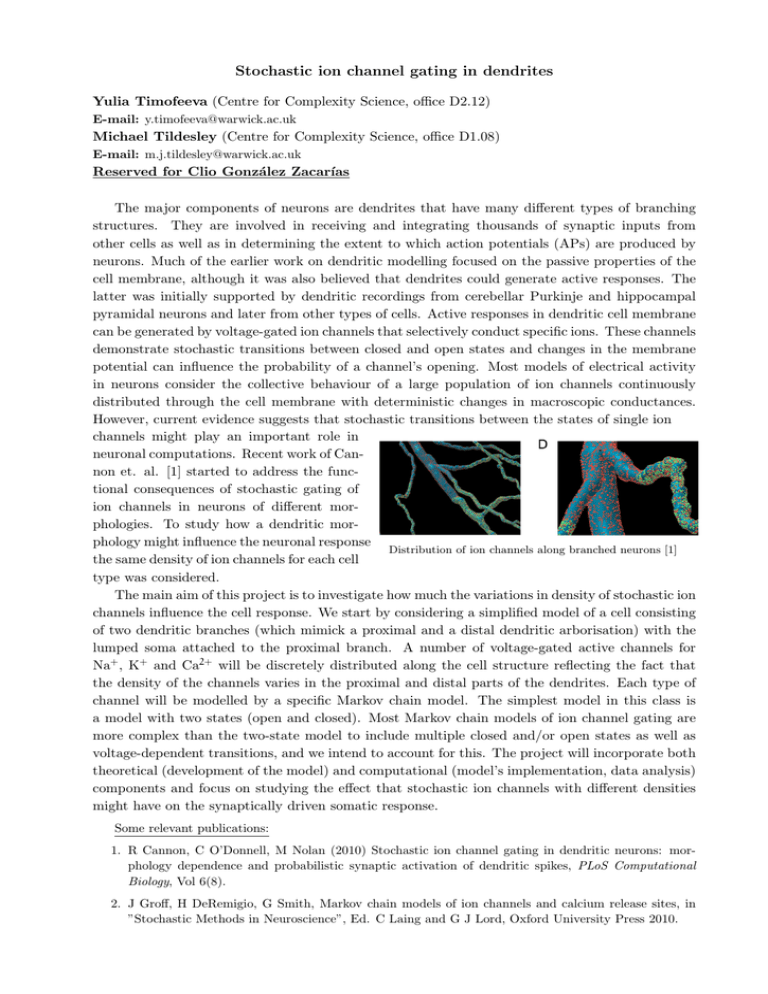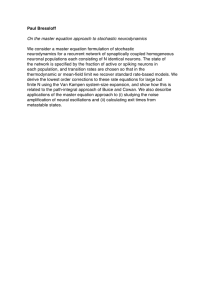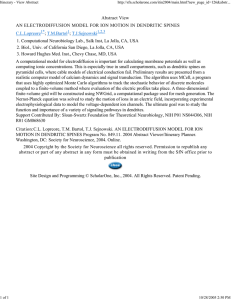Stochastic ion channel gating in dendrites
advertisement

Stochastic ion channel gating in dendrites Yulia Timofeeva (Centre for Complexity Science, office D2.12) E-mail: y.timofeeva@warwick.ac.uk Michael Tildesley (Centre for Complexity Science, office D1.08) E-mail: m.j.tildesley@warwick.ac.uk Reserved for Clio González Zacarı́as The major components of neurons are dendrites that have many different types of branching structures. They are involved in receiving and integrating thousands of synaptic inputs from other cells as well as in determining the extent to which action potentials (APs) are produced by neurons. Much of the earlier work on dendritic modelling focused on the passive properties of the cell membrane, although it was also believed that dendrites could generate active responses. The latter was initially supported by dendritic recordings from cerebellar Purkinje and hippocampal pyramidal neurons and later from other types of cells. Active responses in dendritic cell membrane can be generated by voltage-gated ion channels that selectively conduct specific ions. These channels demonstrate stochastic transitions between closed and open states and changes in the membrane potential can influence the probability of a channel’s opening. Most models of electrical activity in neurons consider the collective behaviour of a large population of ion channels continuously distributed through the cell membrane with deterministic changes in macroscopic conductances. However, current evidence suggests that stochastic transitions between the states of single ion channels might play an important role in neuronal computations. Recent work of Cannon et. al. [1] started to address the functional consequences of stochastic gating of ion channels in neurons of different morphologies. To study how a dendritic morphology might influence the neuronal response Distribution of ion channels along branched neurons [1] the same density of ion channels for each cell type was considered. The main aim of this project is to investigate how much the variations in density of stochastic ion channels influence the cell response. We start by considering a simplified model of a cell consisting of two dendritic branches (which mimick a proximal and a distal dendritic arborisation) with the lumped soma attached to the proximal branch. A number of voltage-gated active channels for Na+ , K+ and Ca2+ will be discretely distributed along the cell structure reflecting the fact that the density of the channels varies in the proximal and distal parts of the dendrites. Each type of channel will be modelled by a specific Markov chain model. The simplest model in this class is a model with two states (open and closed). Most Markov chain models of ion channel gating are more complex than the two-state model to include multiple closed and/or open states as well as voltage-dependent transitions, and we intend to account for this. The project will incorporate both theoretical (development of the model) and computational (model’s implementation, data analysis) components and focus on studying the effect that stochastic ion channels with different densities might have on the synaptically driven somatic response. Some relevant publications: 1. R Cannon, C O’Donnell, M Nolan (2010) Stochastic ion channel gating in dendritic neurons: morphology dependence and probabilistic synaptic activation of dendritic spikes, PLoS Computational Biology, Vol 6(8). 2. J Groff, H DeRemigio, G Smith, Markov chain models of ion channels and calcium release sites, in ”Stochastic Methods in Neuroscience”, Ed. C Laing and G J Lord, Oxford University Press 2010.





